Do you have a question about the MSI Z370-A and is the answer not in the manual?
Steps to prevent ESD damage during handling of components.
Guidelines on safe handling, power connection, humidity, and pre-power on checks.
Step-by-step visual guide for mounting the CPU onto the motherboard socket.
Visual guide detailing how to insert DDR4 memory modules into the DIMM slots.
Diagram and pin assignments for connecting front panel headers like power and reset.
Steps for installing the I/O shield and securing the motherboard within the computer case.
Instructions for placing storage drives in the chassis and connecting SATA data/power cables.
Steps for inserting a graphics card into the appropriate PCIe slot.
Diagram illustrating how to connect peripherals to the motherboard's rear ports.
Guide for connecting the 24-pin ATX main power and 8-pin CPU power cables.
Steps for connecting the power cord and initiating system power-on.
Details on compatible CPUs, the Z370 chipset, and DDR4 memory specifications.
Specifications for SATA, M.2 slots, USB, and LAN ports.
A labeled diagram showing the location of all motherboard connectors and headers.
Step-by-step visual instructions for correctly mounting the LGA 1151 CPU.
Critical advice on CPU handling, heatsink installation, and socket pin protection.
Visual guide for inserting DDR4 memory modules into the DIMM slots.
Important recommendations for memory compatibility, capacity, and cooling.
Step-by-step instructions for installing M.2 SSDs or Intel Optane memory modules.
Detailed pin assignments for the 24-pin ATX main power and 8-pin CPU power connectors.
Description of the JBAT1 jumper and steps to reset BIOS to default values.
Explanation of the EZ Debug LED indicators for troubleshooting boot issues.
Various methods to access the BIOS setup interface during system boot.
Instructions for restoring BIOS settings to their default values.
Guides for updating the BIOS using M-FLASH via USB and Live Update 6.
Adjusting CPU ratio for different core counts and related frequency settings.
Configuring CPU ratio operating modes and offsets for dynamic adjustments.
Adjusting CPU base clock and configuring Extreme Memory Profile (XMP).
Detailed settings for configuring memory timings for optimal performance.
Adjusting CPU voltages and configuring loadline calibration for stability.
Configuring TDP power limits and clock frequencies for CPU performance.
Step-by-step guide for updating the system BIOS using the M-FLASH utility.
Adjusting fan modes (PWM/DC) and fan speeds for optimal cooling.
Step-by-step instructions for updating the system using LIVE UPDATE 6.
How to change CPU frequency and base clock within COMMAND CENTER.
Adjusting CPU fan speed and CPU voltage using the utility.
Configuring DRAM frequency, voltage, and integrated graphics settings.
Configuring LED effects specifically for the motherboard's lighting zones.
Step-by-step instructions for creating RAID volumes using Intel RST Option ROM.
Procedures for deleting RAID volumes and resetting disks to non-RAID.
Step-by-step guide for installing the Optane module and configuring BIOS settings.
Final steps to enable Optane memory and critical usage warnings.
Procedures for disabling and safely removing Intel Optane memory.
Using MSI SMART TOOL to disable Optane and revert SATA mode to AHCI.
Diagnosing and resolving problems related to power, monitor signal, and boot failures.
Steps to prevent ESD damage during handling of components.
Guidelines on safe handling, power connection, humidity, and pre-power on checks.
Step-by-step visual guide for mounting the CPU onto the motherboard socket.
Visual guide detailing how to insert DDR4 memory modules into the DIMM slots.
Diagram and pin assignments for connecting front panel headers like power and reset.
Steps for installing the I/O shield and securing the motherboard within the computer case.
Instructions for placing storage drives in the chassis and connecting SATA data/power cables.
Steps for inserting a graphics card into the appropriate PCIe slot.
Diagram illustrating how to connect peripherals to the motherboard's rear ports.
Guide for connecting the 24-pin ATX main power and 8-pin CPU power cables.
Steps for connecting the power cord and initiating system power-on.
Details on compatible CPUs, the Z370 chipset, and DDR4 memory specifications.
Specifications for SATA, M.2 slots, USB, and LAN ports.
A labeled diagram showing the location of all motherboard connectors and headers.
Step-by-step visual instructions for correctly mounting the LGA 1151 CPU.
Critical advice on CPU handling, heatsink installation, and socket pin protection.
Visual guide for inserting DDR4 memory modules into the DIMM slots.
Important recommendations for memory compatibility, capacity, and cooling.
Step-by-step instructions for installing M.2 SSDs or Intel Optane memory modules.
Detailed pin assignments for the 24-pin ATX main power and 8-pin CPU power connectors.
Description of the JBAT1 jumper and steps to reset BIOS to default values.
Explanation of the EZ Debug LED indicators for troubleshooting boot issues.
Various methods to access the BIOS setup interface during system boot.
Instructions for restoring BIOS settings to their default values.
Guides for updating the BIOS using M-FLASH via USB and Live Update 6.
Adjusting CPU ratio for different core counts and related frequency settings.
Configuring CPU ratio operating modes and offsets for dynamic adjustments.
Adjusting CPU base clock and configuring Extreme Memory Profile (XMP).
Detailed settings for configuring memory timings for optimal performance.
Adjusting CPU voltages and configuring loadline calibration for stability.
Configuring TDP power limits and clock frequencies for CPU performance.
Step-by-step guide for updating the system BIOS using the M-FLASH utility.
Adjusting fan modes (PWM/DC) and fan speeds for optimal cooling.
Step-by-step instructions for updating the system using LIVE UPDATE 6.
How to change CPU frequency and base clock within COMMAND CENTER.
Adjusting CPU fan speed and CPU voltage using the utility.
Configuring DRAM frequency, voltage, and integrated graphics settings.
Configuring LED effects specifically for the motherboard's lighting zones.
Step-by-step instructions for creating RAID volumes using Intel RST Option ROM.
Procedures for deleting RAID volumes and resetting disks to non-RAID.
Step-by-step guide for installing the Optane module and configuring BIOS settings.
Final steps to enable Optane memory and critical usage warnings.
Procedures for disabling and safely removing Intel Optane memory.
Using MSI SMART TOOL to disable Optane and revert SATA mode to AHCI.
Diagnosing and resolving problems related to power, monitor signal, and boot failures.
| Chipset | Intel Z370 |
|---|---|
| CPU Socket | LGA 1151 |
| Form Factor | ATX |
| Memory Type | DDR4 |
| Memory Slots | 4 |
| Maximum Memory | 64 GB |
| PCIe x16 Slots | 2 |
| SATA Ports | 6 |
| USB 3.1 Gen 2 Type-A | 1 |
| USB 2.0 | 6 |
| LAN | 1 x Realtek RTL8111H Gigabit LAN |
| RAID Support | 0/1/5/10 |
| Multi-GPU Support | AMD CrossFire |

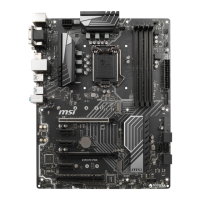


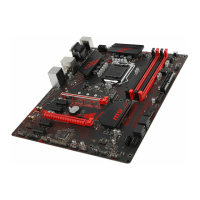
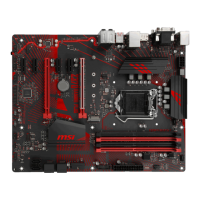



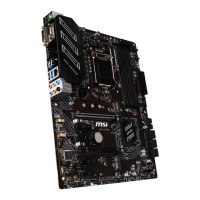
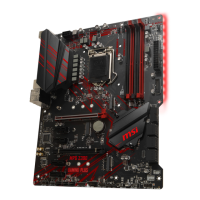

